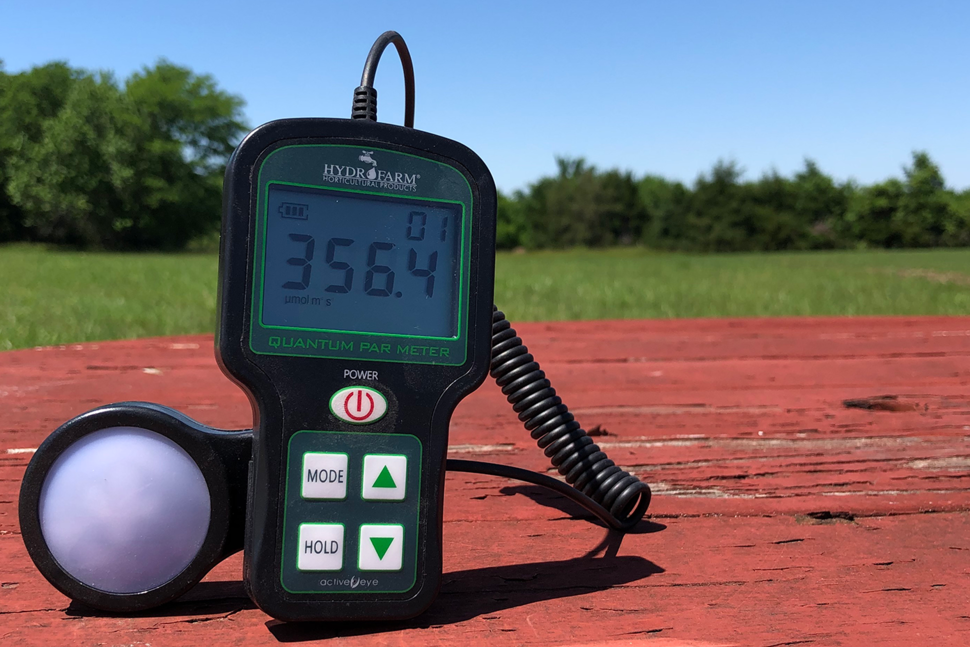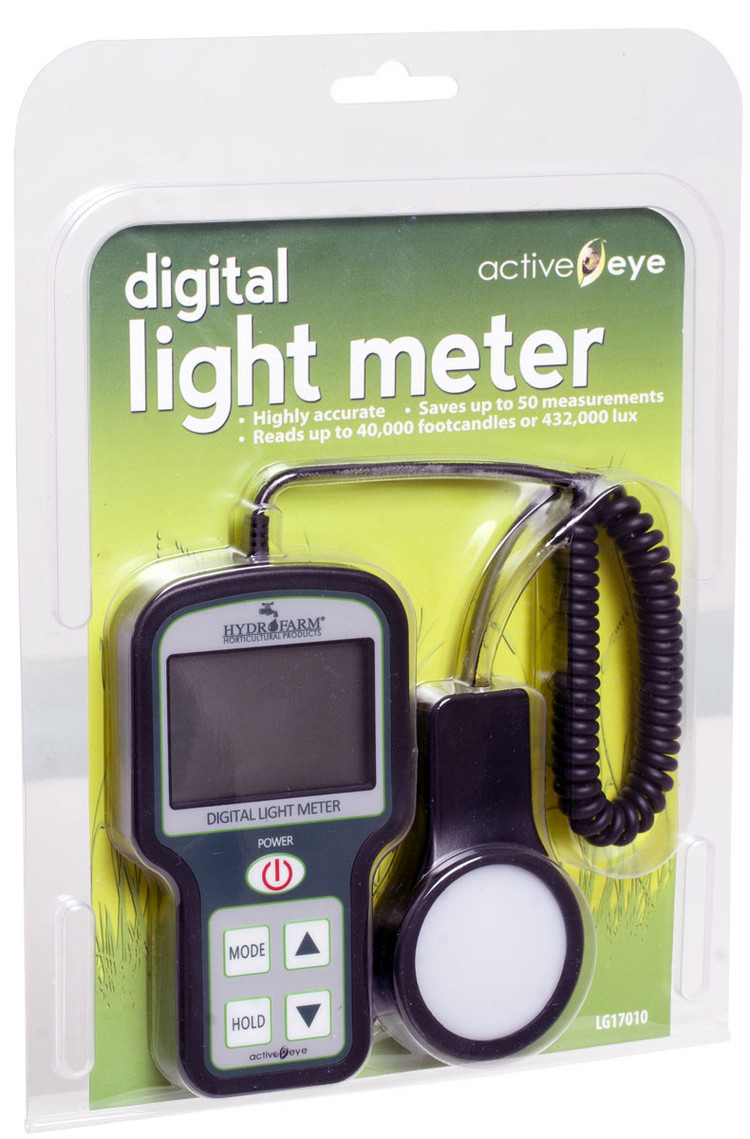Measuring Light Intensity

Regardless of whether or not you've ever grown a plant, you most likely know that plants require light in order to grow through a process called photosynthesis. Photosynthesis uses energy from light to assist in the conversion of carbon dioxide and water into chemical energy or carbohydrates. This is what provides fuel to the cells inside the plant. While the amount and type of light needed to perform this activity can vary dramatically between species of plants, their stages of growth and other environmental factors, there are a handful of affordable tools available to measure how much light your plants are receiving.
Understanding Light
All around us, every minute of every day, are waves of electromagnetic radiation carrying energy. Each of those waves have specific lengths or spectrums. For instance, your microwave uses specific wavelengths of electromagnetic radiation to agitate the molecules in your food, heating it up. When you listen to the radio in your car, you're just tuning in to a specific wavelength of electromagnetic radiation. And just like your microwave or your radio, light is also electromagnetic radiation in a certain spectrum; the only difference is that it can actually be seen with the naked eye.
One other important aspect of light is that those waves of radiation are comprised of particles called photons. That becomes important later in this article when we discuss indoor lighting, but we'll avoid going into any more detail on photons or this could turn into a quantum physics debate on mass-less particles - no one wants that from their local garden store.
Plant-available Light
So, here we are with waves of radiation flowing through us, around us and across the universe. We call the ones we can see "visible light," but plants are slightly different than people. The light they use to perform photosynthesis falls within a narrow range of wavelengths between 400 and 700 nanometers long. This range, or spectrum, is called photosynthetically active radiation - PAR for short.
Each wavelength also represents a specific color of visible light. This range goes from dark blue at 400 nanometers to dark red at 700 nanometers. The most significant amount of photosynthesis in plants occurs in the PAR ranges that are heavier in blues, oranges and reds. That's why you'll often see LED grow lights that put off a purple hue rather than white light. Instead of adding diodes for all colors in the visible spectrum, they use only diodes in specific wavelengths that are most usable by plants. Whether or not that's the best method of producing LED lighting for plant growth is a debate for a different article.

Depending on your plant and its stage of growth, the optimal amount of PAR can range from very little in the seedling stage (100-400ppfd) to fairly large for flowering plants (700-1,200ppfd). There's also a significant difference between the minimum amount of PAR necessary for plant growth versus the maximum that can realistically be used by the plant. Beyond a certain point, additional PAR would become waste.
Measuring the amount of PAR can be done with a PAR/ppfd meter. Using a sensor, this meter calculates the density of photons within the PAR spectrum contacting a specific area every second. As you move the sensor farther away from the light source, you'll notice the ppfd value goes down as less light is reaching the meter.

Color Temperature
Also important when it comes to feeding light to your plant, is the color temperature of your bulbs. This is measured in Kelvin and typically ranges from 2,000K (warmer) to 8,000K (cooler). An easy way to think about Kelvin is the "warmth" of a bulb. When you're replacing a light bulb in your house, you may want a softer, warmer bulb to create a relaxing environment. That would fall in the 2,700K-3,000K range. If you want a cooler light that provides more of a daylight environment, 4,500K-6,500K would give that feel.

While not as applicable to LEDs where the spectrum of light color is controlled very precisely by the diodes used, selecting an appropriate color temperature for fluorescent and high intensity discharge (HID) lamps is critical. During vegetative growth, plants tend to prefer higher Kelvin values with more blues and whites. Once flowering begins, lower Kelvin values, made up heavily of reds and oranges, are ideal.
The color temperature of a bulb will be displayed on its packaging or in the description of the product. This is not something you would typically measure at home with a meter or device.
Other Ways to Measure
While PAR/ppfd is our preferred method of measuring plant-available light, there are other options. The difference is that these other measures do not account for the type or temperature of light being produced. They simply provide the amount, intensity or coverage area of a bulb.
Lumens: This is a measure of the total amount of light emitted by a bulb, also referred to as its brightness.
Flux: This is the amount of lumens emitted by a bulb per second.
Lux: This is a unit of measure derived from lumens. One lux is equal to one lumen per square meter.
Footcandle: Similar to lux, a footcandle is equal to one lumen per square foot.
These measurements can be easily recorded with a Digital Light Meter, like the one below.

What's the Deal with Watts?
When it comes to horticultural lighting, we constantly find ourselves talking about light in watts, and, without a doubt, watts are important. They just aren't a measure of light intensity. Watts are a measure of electrical usage. For instance, a 600 watt bulb would use 600 watts of electricity per hour. To put this in kilowatts, divide it by 1,000. Therefore, your 600 watt bulb uses 0.6 kilowatts per hour.
You can then extrapolate the cost to run your light for an hour by taking the cost of electricity per kilowatt-hour (kWh) from your electrical bill and multiplying it by the number of kilowatts your light uses per hour.
0.6 kW x $0.10 per kWh = $0.06/hour
In this scenario, it would cost you 6 cents per hour to run this light.
If this is all about electricity and cost, then why even talk about watts when it comes to light intensity? Well, in general, the more electricity (wattage) your bulb uses, the brighter and more intense the light emitted tends to be. A 1,000 watt bulb, in most cases, will provide a greater amount of light intensity than a 600 watt bulb. What's occurring inside your light is the conversion of electrical energy (electrons) to light energy (photons). In a perfect world, for every electron that came into your light, one photon would be produced and the light would be perfectly efficient. That's not the case, though, because converting electrons to photons creates at least some heat that is lost from the system. Different bulbs, fixtures and ballasts have different levels of efficiency during this process which is why watts-alone can't be used to determine the actual light intensity of a bulb.
Our Recommendation
In our opinion, the PAR/ppfd meter is the best tool for the job when measuring plant-available light, but regardless of the tool or technique you use to measure light, use something. This will help you gather data that would be otherwise difficult to collect with the naked-eye. Record that data and how your plant responds as the measurements change. That way, it will be much easier to make informed decisions on the type of lights to purchase, distance to place them from your plants, etc.




